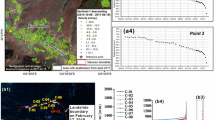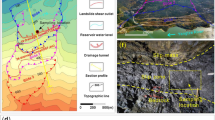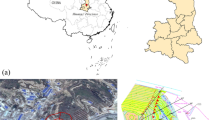Abstract
The determination of landslide stabilities and thrust forces is the premise for designing landslide stabilizing structures. The shear strength of the slip zone, which is a key factor affecting the stability and thrust force of landslides, constantly changes in time and space with landslide movement. Therefore, this phenomenon should be considered. In this study, a method that dynamically evaluates landslide stabilities and thrust forces by considering the variation in the shear strength of the slip zone with landslide movement by technically utilizing the whole process data of the ring shear test is proposed. The method was applied to the Huangtupo landslide in the Three Gorges Reservoir area of China. The results demonstrate that the proposed method has obvious advantages in considering uneven deformation of the landslide and the gradual weakening process of the shear strength of the slip zone. Moreover, the spatial distribution of the weakening coefficient that reflects the weakening degree of the shear strength of the slip zone proved to be quantitatively described well by the S-shaped curve equation.














Similar content being viewed by others
Abbreviations
- D :
-
Soil damage degree with a value ranging from 0 to 1
- F r :
-
Strength reduction factor
- F sa :
-
Safety coefficient
- F st :
-
Landslide stability coefficient
- F sp i :
-
Seepage force of slice i
- G :
-
Shear modulus of the soil
- h :
-
Effective thickness of the specimen in the shear test
- j :
-
Hydraulic gradient and approximately equals sinθi
- k :
-
Weakening coefficient
- K s :
-
Shear stiffness
- L :
-
Horizontal length of the slide zone
- l i :
-
Bottom length of the slice
- l x :
-
Distance between position x and the leading edge
- m :
-
Shear constitutive model parameter related to shear strength decay rate
- N i :
-
Normal force of slice i
- P i :
-
Thrust of slice i
- P i −1 :
-
Thrust from slice i − 1
- P n :
-
Thrust of the last slice
- R i :
-
Resistance force
- T i :
-
Sliding force of slice i
- u :
-
Shear displacement along the shearing direction
- u 0 :
-
Shear constitutive model parameter related to peak displacement and peak strength
- u L :
-
Horizontal displacement of the leading edge of the landslide
- u p :
-
Shear displacement at peak point
- u x :
-
Horizontal displacement of the landslide at position x
- u y :
-
Shear displacement at yield point
- V b i :
-
Submerged volume of slice i
- W a i :
-
Natural weight of the upper part above the phreatic surface
- W b i :
-
Effective weight of the lower part that is fully submerged
- W i :
-
Weight of slice i
- x :
-
Horizontal position of the slip zone
- α i :
-
Slip surface dipping angle at slice i
- α i −1 :
-
Slip surface dipping angle at slice i − 1
- γ :
-
Shear strain of the soil
- γ w :
-
Unit weight of water
- θ i :
-
Slope angle of the phreatic surface in slice i
- σ n :
-
Normal stress
- σ n i :
-
Normal stress on the slip surface of slice i
- τ :
-
Shear strength of the slip zone soil
- τ′:
-
Shear strength of the undamaged portion of the soil
- τ′′:
-
Shear strength of the damaged portion of the soil
- τ p :
-
Peak strength
- τ r :
-
Residual strength
- τ s :
-
Shear strength corresponding to the relative shear displacement
- τ s i :
-
Average shear strength of the slip surface at slice i
References
Bernander S, Kullingsjö A, Gylland AS, Bengtsson PE, Knutsson S, Pusch R, Olofsson J, Elfgren L (2016) Downhill progressive landslides in long natural slopes: triggering agents and landslide phases modeled with a finite difference method. Can Geotech J 53(10):1565–1582. https://doi.org/10.1139/cgj-2015-0651
Biniyaz A, Azmoon B, Liu Z (2022) Coupled transient saturated–unsaturated seepage and limit equilibrium analysis for slopes: influence of rapid water level changes. Acta Geotech 17:2139–2156. https://doi.org/10.1007/s11440-021-01359-7
Chen H, Ma WL, Yuan XQ, Niu CC, Shi B, Tian GL (2022) Influence of stress conditions on shear behavior of slip zone soil in ring shear test: an experimental study and numerical simulation. Nat Hazards 111:1179–1197. https://doi.org/10.1007/s11069-021-05090-0
Chen XP, Zhu HH, Huang JW, Liu D (2016) Stability analysis of an ancient landslide considering shear strength reduction behavior of slip zone soil. Landslides 13(1):173–181. https://doi.org/10.1007/s10346-015-0629-7
Dumperth C, Roho J, Fleer A, Xiang W (2016) Local-scale assessment of the displacement pattern of a densely populated landslide, utilizing finite element software and terrestrial radar interferometry: a case study on Huangtupo landslide (P.R. China). Environ Earth Sci 75(10):880. https://doi.org/10.1007/s12665-016-5475-y
Dykes AP, Bromhead EN (2018) New, simplified and improved interpretation of the Vaiont landslide mechanics. Landslides 15(10):2001–2015. https://doi.org/10.1007/s10346-018-0998-9
Fan ZQ, Tang HM, Tan QW, Yang YM, Wen T (2019) Ring shear tests of slip soil and their enlightenment to critical strength of reservoir landslides. Chinese J Geotech Eng 41(9):1698–1706. https://doi.org/10.11779/CJGE201909014
Godayal A, Gupta AD, Rao SY (2019) Long term landslide mitigation technique illustrated-a case study. Disaster Dev 8(1–2):65–75. https://doi.org/10.35629/5252-030511581166
Gong WP, Juang CH, Wasowski J (2021) Geohazards and human settlements: lessons learned from multiple relocation events in Badong, China - Engineering geologist’s perspective. Eng Geol. https://doi.org/10.1016/j.enggeo.2021.106051
Hammouri NA, Malkawi AIH, Yamin MM (2008) Stability analysis of slopes using the finite element method and limiting equilibrium approach. Bull Eng Geol Environ 67(4):471–478. https://doi.org/10.1007/s10064-008-0156-z
Hu XL, Tang HM, Li CD, Sun RX (2012) Stability of Huangtupo riverside slumping mass II# under water level fluctuation of Three Gorges Reservoir. J Earth Sci 23(3):326–334. https://doi.org/10.1007/s12583-012-0259-0
Jiang Y, Wang GH, Kamai T (2017) Fast shear behavior of granular materials in ring-shear tests and implications for rapid landslides. Acta Geotech 12:645–655. https://doi.org/10.1007/s11440-016-0508-y
Juang CH (2021) BFTS - Engineering geologists’ field station to study reservoir landslides. Eng Geol. https://doi.org/10.1016/j.enggeo.2021.106038
Kimura S, Nakamura S, Vithana SB, Sakai K (2014) Shearing rate effect on residual strength of landslide soils in the slow rate range. Landslides 11(6):969–979. https://doi.org/10.1007/s10346-013-0457-6
Kirschbaum DB, Adler R, Hong Y, Hill S, Lam AL (2010) A global landslide catalog for hazard applications: method, results, and limitations. Nat Hazards 52(3):561–575. https://doi.org/10.1007/s11069-009-9401-4
Krkac M, Gazibara SB, Arbanas Z, Secanj M, Arbanas SM (2020) A comparative study of random forests and multiple linear regression in the prediction of landslide velocity. Landslides 17(11):2515–2531. https://doi.org/10.1007/s10346-020-01476-6
Lambe TW, Whitman RV (2008) Soil mechanics SI version. John Wiley and Sons, Hoboken
Li CD, Wu JJ, Tang HM, Wang J, Chen F, Liang DM (2015) A novel optimal plane arrangement of stabilizing piles based on soil arching effect and stability limit for 3D colluvial landslides. Eng Geol 195:236–247. https://doi.org/10.1016/j.enggeo.2015.06.018
Li DY, Yin KL, Glade T, Leo C (2017) Effect of over-consolidation and shear rate on the residual strength of soils of silty sand in the three Gorges Reservoir. Sci Rep 7(1):5503–5511. https://doi.org/10.1038/s41598-017-05749-4
Liu XR, Kou MM, Feng H, Zhou Y (2018) Experimental and numerical studies on the deformation response and retaining mechanism of h-type anti-sliding piles in clay landslide. Environ Earth Sci 77(5):1–14. https://doi.org/10.1007/s12665-018-7360-3
Luo Y, Xu Q, He SM, Li XP, He JC, Wu Y (2015) A new method to calculate lateral force acting on stabilizing piles based on multi-wedge translation mechanism. J Cent South Univ 22(2):654–661. https://doi.org/10.1007/s11771-015-2567-x
Luo YF, Zou ZX, Li CD, Duan HJ, Thaw NMM, Zhang BC, Ding BD, Zhang JR (2022) Analysis of shear constitutive models of the slip zone soil based on various statistical damage distributions. Appl Sci 12(7):3493. https://doi.org/10.3390/app12073493
Miao FS, Wu YP, Li LW, Tang HM, Xiong F (2020) Weakening laws of slip zone soils during wetting–drying cycles based on fractal theory: a case study in the Three Gorges Reservoir (China). Acta Geotech 15:1909–1923. https://doi.org/10.1007/s11440-019-00894-8
Miao TD, Ma CW, Wu SZ (1999) Evolution model of progressive failure of landslides. J Geotech Geoenviron Eng 125(10):827–831. https://doi.org/10.1061/(ASCE)1090-0241(1999)125:10(827)
Rasigraf O, Wagner D (2022) Landslides: an emerging model for ecosystem and soil chronosequence research. Earth Sci Rev 231:104064. https://doi.org/10.1016/j.earscirev.2022.104064
Scott CR (1978) Soil mechanics and foundations. Applied Science Publishers, London
Skempton AW (1964) Long-term stability of clay slopes. Géotechnique 14(2):77–102
Sun GH, Jiang W, Cheng SG, Zheng H (2016) Optimization model for determining safety factor and thrust line in landslide assessments. Int J Geomech 17(4):04016091. https://doi.org/10.1061/(ASCE)GM.1943-5622.0000785
Tan QW, Tang HM, Huang L, Li CD, Kou T (2018a) LSP methodology for determining the optimal stabilizing pile location for step-shaped soil sliding. Eng Geol 232:56–67. https://doi.org/10.1016/j.enggeo.2017.11.005
Tan QW, Tang HM, Fan L, Xiong CR, Fan ZQ, Zhao M, Wang DJ, Zou ZX (2018b) In situ triaxial creep test for investigating deformational properties of gravelly sliding zone soil: example of the Huangtupo 1# landslide, China. Landslides 15:2499–2508. https://doi.org/10.1007/s10346-018-1062-5
Tan QW, Huang MS, Tang HM, Zou ZX, Li CD, Huang L, Zhou XX (2022) Insight into the anisotropic deformation of landslide sliding zone soil containing directional cracks based on in situ triaxial creep test and numerical simulation. Eng Geol 311:106898. https://doi.org/10.1016/j.enggeo.2022.106898
Tang HM, Li CD, Hu XL, Su AJ, Wang LQ, Wu YP, Criss R, Xiong CR, Li YA (2015a) Evolution characteristics of the Huangtupo landslide based on in situ tunneling and monitoring. Landslides 12(3):511–521. https://doi.org/10.1007/s10346-014-0500-2
Tang HM, Zou ZX, Xiong CR, Wu YP, Hu XL, Wang LQ, Lu S, Criss RE, Li CD (2015b) An evolution model of large consequent bedding rockslides, with particular reference to the Jiweishan rockslide in Southwest China. Eng Geol 186:17–27. https://doi.org/10.1016/j.enggeo.2014.08.021
Tang HM, Wasowski J, Juang CH (2019) Geohazards in the three Gorges Reservoir Area, China - Lessons learned from decades of research. Eng Geol 261:105267. https://doi.org/10.1016/j.enggeo.2019.105267
Terzaghi K, Peck RB, Mesri G (1996) Soil mechanics in engineering practice, 3rd edn. Wiley, New York, pp 267–277
Tordesillas A, Kahagalage S, Campbell L, Bellett P, Intrieri E, Batterham R (2021) Spatiotemporal slope stability analytics for failure estimation (SSSAFE): linking radar data to the fundamental dynamics of granular failure. Sci Rep 11(1):9729. https://doi.org/10.1038/s41598-021-88836-x
Troncone A, Conte E, Donato A (2014) Two and three-dimensional numerical analysis of the progressive failure that occurred in an excavation-induced landslide. Eng Geol 183:265–275. https://doi.org/10.1016/j.enggeo.2014.08.027
Wang DY, Zhu HH, Wang J, Sun YJ, Schenato L, Pasuto A, Shi B (2023) Characterization of sliding surface deformation and stability evaluation of landslides with fiber–optic strain sensing nerves. Eng Geol 314:107011. https://doi.org/10.1016/j.enggeo.2023.107011
Wang JE, Xiang W, Lu N (2014) Landsliding triggered by reservoir operation: a general conceptual model with a case study at Three Gorges Reservoir. Acta Geotech 9(5):771–788. https://doi.org/10.1007/s11440-014-0315-2
Wang JE, Su AJ, Liu QB, Xiang W, Yeh HF, Xiong CR, Zou ZX, Zhong C, Liu JQ, Cao S (2018) Three-dimensional analyses of the sliding surface distribution in the Huangtupo No. 1 riverside sliding mass in the Three Gorges Reservoir area of China. Landslides 15(7):1425–1435. https://doi.org/10.1007/s10346-018-1003-3
Wang ZD (2010) Fundamentals of statistics. China Statistics Press, Beijing, pp 168–169
Wang ZH, Zhou J (2012) Three-dimensional numerical simulation and earth pressure analysis on doublerow piles with consideration of spatial effects. J Zhejiang Univ Sci (appl Phys Eng) 12(10):758–770. https://doi.org/10.1631/jzus.A1100067
Wu YX, Liu DS, Wang L, Xin Q (2012) The Calculation of landslide-thrust based on reliability theory. Appl Mech Mater 226:1293–1296. https://doi.org/10.4028/www.scientific.net/AMM.226-228.1293
Xiao SG, Tu WB (2011) The effect of slide mass and pile stiffness on residual thrust on stabilizing piles. Appl Mech Mater 90:2068–2072. https://doi.org/10.4028/www.scientific.net/AMM.90-93.2068
Xie SJ, Lin H, Chen YF, Yong R, Xiong W, Du SG (2020) A damage constitutive model for shear behavior of joints based on determination of the yield point. Int J Rock Mech Min Sci 128:104269. https://doi.org/10.1016/j.ijrmms.2020.104269
Yamagami T, Takimazaka Z, Jiang J (1999) Progressive failure analysis of slopes based on LEM. In: Balkema AA (ed) slope stability engineering, Rotterdam, Netherlands, pp 293–298
Ye X, Zhu HH, Wang J, Zhang Q, Shi B, Schenato L, Pasuto A (2022) Subsurface Multi-Physical Monitoring of a Reservoir Landslide With the Fiber-Optic Nerve System. Geophys Res Lett. https://doi.org/10.1029/2022GL098211
Zhu R, Xie WL, Liu QQ, Yang H, Wang QY (2022) Shear behavior of sliding zone soil of loess landslides via ring shear tests in the South Jingyang Plateau. Bull Eng Geol Environ 81:244. https://doi.org/10.1007/s10064-022-02719-7
Zou ZX, Luo T, Zhang S, Duan HJ, Li SW, Wang JE, Deng JW (2023) A novel method to evaluate the time-dependent stability of reservoir landslides: exemplified by Outang landslide in the Three Gorges Reservoir. Landslides. https://doi.org/10.1007/s10346-023-02056-0
Zou ZX, Mu R, Luo YF, Guo B, Tan L, Su AJ, Tang CY (2022) Progressive evaluation of buckling landslide stability considering strain softening behavior of the slip zone. Int J Numer Anal Met 46(14):2680–2697. https://doi.org/10.1002/nag.3422
Zou ZX, Yan JB, Tang HM, Wang S, Xiong CR, Hu XL (2020) shear constitutive model for describing the full process of the deformation and failure of slip zone soil. Eng Geol. https://doi.org/10.1016/j.enggeo.2020.105766
Funding
This work was supported by the National Natural Science Foundation of China (Nos. 42077268, 42020104006, 42007268), and the Natural Science Foundation of Hubei Province of China (2020CFB451).
Author information
Authors and Affiliations
Contributions
All authors contributed to the study conception and design. Material preparation were performed by ZZ and JY. Data collection were done by TL and YL. Analysis were performed by QT and XH. The first draft of the manuscript was written by ZZ and TL. All authors commented on previous versions of the manuscript. All authors read and approved the final manuscript.
Corresponding author
Ethics declarations
Conflict of interest
The authors have no relevant financial or non-financial interests to disclose.
Additional information
Publisher's Note
Springer Nature remains neutral with regard to jurisdictional claims in published maps and institutional affiliations.
Rights and permissions
Springer Nature or its licensor (e.g. a society or other partner) holds exclusive rights to this article under a publishing agreement with the author(s) or other rightsholder(s); author self-archiving of the accepted manuscript version of this article is solely governed by the terms of such publishing agreement and applicable law.
About this article
Cite this article
Zou, Z., Luo, T., Tan, Q. et al. Dynamic determination of landslide stability and thrust force considering slip zone evolution. Nat Hazards 118, 31–53 (2023). https://doi.org/10.1007/s11069-023-05992-1
Received:
Accepted:
Published:
Issue Date:
DOI: https://doi.org/10.1007/s11069-023-05992-1




